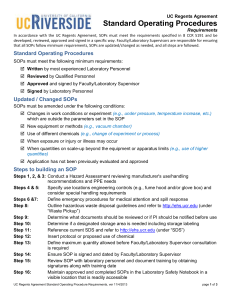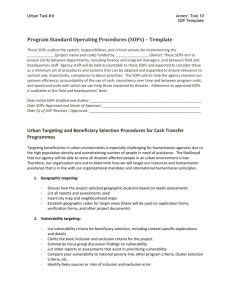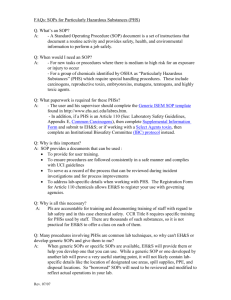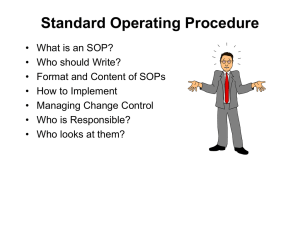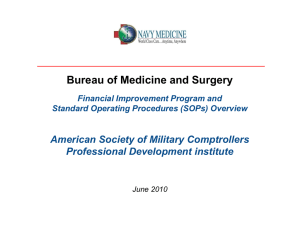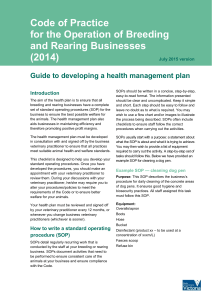SOP Guidelines - OSU Chemistry
advertisement
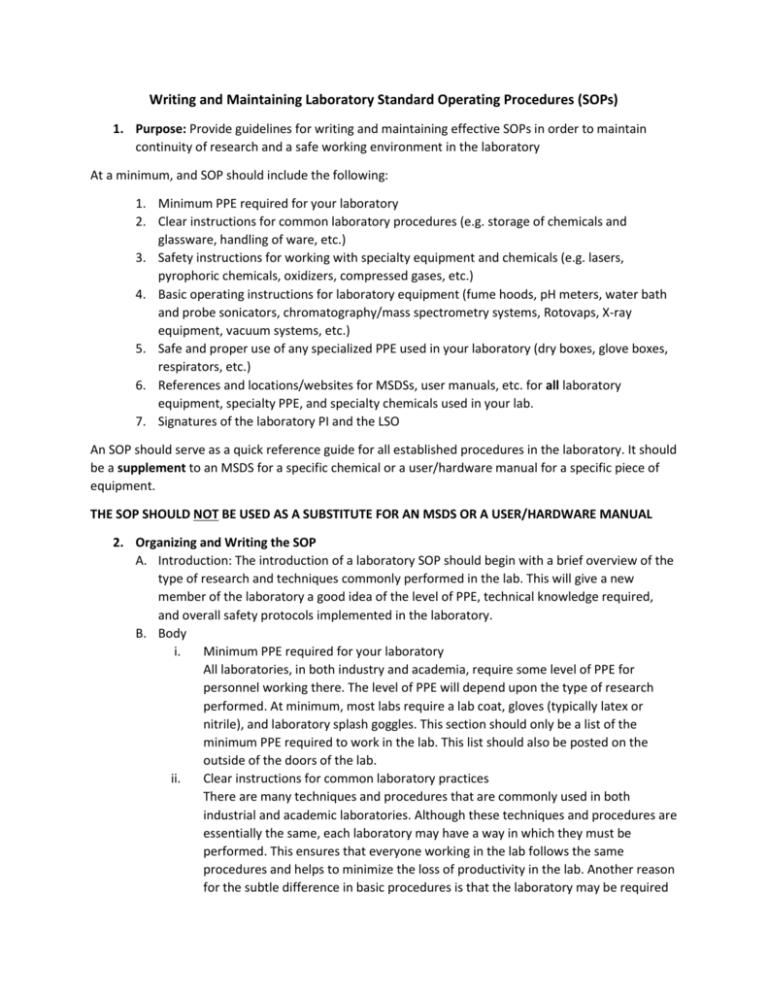
Writing and Maintaining Laboratory Standard Operating Procedures (SOPs) 1. Purpose: Provide guidelines for writing and maintaining effective SOPs in order to maintain continuity of research and a safe working environment in the laboratory At a minimum, and SOP should include the following: 1. Minimum PPE required for your laboratory 2. Clear instructions for common laboratory procedures (e.g. storage of chemicals and glassware, handling of ware, etc.) 3. Safety instructions for working with specialty equipment and chemicals (e.g. lasers, pyrophoric chemicals, oxidizers, compressed gases, etc.) 4. Basic operating instructions for laboratory equipment (fume hoods, pH meters, water bath and probe sonicators, chromatography/mass spectrometry systems, Rotovaps, X-ray equipment, vacuum systems, etc.) 5. Safe and proper use of any specialized PPE used in your laboratory (dry boxes, glove boxes, respirators, etc.) 6. References and locations/websites for MSDSs, user manuals, etc. for all laboratory equipment, specialty PPE, and specialty chemicals used in your lab. 7. Signatures of the laboratory PI and the LSO An SOP should serve as a quick reference guide for all established procedures in the laboratory. It should be a supplement to an MSDS for a specific chemical or a user/hardware manual for a specific piece of equipment. THE SOP SHOULD NOT BE USED AS A SUBSTITUTE FOR AN MSDS OR A USER/HARDWARE MANUAL 2. Organizing and Writing the SOP A. Introduction: The introduction of a laboratory SOP should begin with a brief overview of the type of research and techniques commonly performed in the lab. This will give a new member of the laboratory a good idea of the level of PPE, technical knowledge required, and overall safety protocols implemented in the laboratory. B. Body i. Minimum PPE required for your laboratory All laboratories, in both industry and academia, require some level of PPE for personnel working there. The level of PPE will depend upon the type of research performed. At minimum, most labs require a lab coat, gloves (typically latex or nitrile), and laboratory splash goggles. This section should only be a list of the minimum PPE required to work in the lab. This list should also be posted on the outside of the doors of the lab. ii. Clear instructions for common laboratory practices There are many techniques and procedures that are commonly used in both industrial and academic laboratories. Although these techniques and procedures are essentially the same, each laboratory may have a way in which they must be performed. This ensures that everyone working in the lab follows the same procedures and helps to minimize the loss of productivity in the lab. Another reason for the subtle difference in basic procedures is that the laboratory may be required to adhere to regulations imposed by federal/state agencies (such as OSHA or the FDA) or by company/university policies. When writing SOPs for these procedures, find out what policies the laboratory must follow to ensure that your SOPs are in compliance. Most agencies (and possibly some universities with large research programs) may have their own SOPs for basic laboratory procedures (http://chemistry.osu.edu/safety/chp). iii. Safety Instructions for Working with Specialty Chemicals Certain chemicals and laboratory equipment have specific hazards associated with them. The types of chemicals and equipment that is used in your lab will depends upon the type of research and experiments your lab performs. Please refer to the List of Common SOPs for examples of hazards that would require an SOP. The MSDS should be used as a key reference to write the SOP for safe and proper handling of each chemical and/or piece of equipment. However, the SOP is NOT a substituted for the MSDS. When writing the SOP for these specialty items, the MSDS should be referenced and easily accessible to everyone working in the lab. iv. Basic Operating Instruction for Laboratory Equipment Laboratories that perform certain types of research require specialized or “homemade”, and often expensive, equipment. Basic procedures for these instruments, such as start-up, routine analysis/maintenance, and shutdown are written specifically to prevent injury to the user and damage to the equipment. These procedures can be found in the User Manual, which should be used as a template when writing your laboratory SOP. More technical procedures, such as replacing parts are also described in the User Manuals but do not need to be included in the SOP. However, the reference location of the User Manuals should be included. v. Safe and Proper Use of Specialized PPE Used in Your Lab Laboratories that routinely use specialty chemicals may require the use of special PPE such as a respirator. This information should be listed in the MSD corresponding to the chemical. Prior to writing the SOP for these items, use the MSDS to verify that specialty PPE is required for handing that chemical and then consult the EHS officer for proper use. C. References and Signatures i. References It is extremely important to provide references to the key document used to write your SOP such as MSDSs and User/Hardware Manuals. If you choose to use other sources to write the SOPs, ensure that they are credible (e.g. OSHA and/or EHS regulations, EHS, University Chemical Hygiene Plan, etc.). Prior to writing your SOPs, it is also important to verify that all documents you reference and use are easily available and accessible to your labmates. ii. Signatures Your SOP should not be put into practice or made available to your labmates until the PI of your lab has reviewed, approved, and signed all SOPs you are planning to implement in your lab. 3. Maintaining your SOPs Maintaining your SOPs is just as important as establishing an SOP for your laboratory. The purpose of maintaining your SOPs are: To ensure that your laboratory remains in compliance with any new policies or changes in policy established by federal and state agencies and the university To provide up-to-date training for all members of the laboratory upon use of new technique in your lab, arrival of a new piece of equipment, or upgrade of an old piece of equipment Although there is no specific timeframe to review your SOPs, you should do it prior to receiving a new member in the lab, when changing LSOs, prior to any laboratory inspection, or whenever your LSO or PI requests a review. 4. Conclusion Laboratory SOPs will vary from lab to lab based on the type of laboratory, research performed, and regulatory policies they are subject to. An SOP is not meant to be a rigid set of instructions; it is a flexible document meant to provide a safe environment for anyone working the lab without sacrificing the productivity of the research performed. This document should be used as a guideline and is meant to provide recommendations for writing an effective laboratory SOP that is applicable to any research laboratory. List of Common Laboratory SOPs This list is not meant to be exhaustive or required for every group. It is meant to act as a guide and represents a variety of topics that are present in current SOPs in CBC. For access to the available SOPs consult the corresponding website *http://chemistry.osu.edu/safety/chp (more general SOPs) †http://ehs.osu.edu/resbiosafety/StandardOP.aspx (chemical-specific SOPs) Reagents: Explosive compounds (azides*, etc) Sure-seal compounds (n-BuLi, etc) Ethidium bromide* Solid pyrophoric materials (LiAlH4, NaH, etc.) Equipment: Rotary evaporators Vacuum ovens Schlenk lines HPLC, GC/GC-MS Polarimeter Autoclave Sonicator Centrifuge Unisoku dewar Vacuum ovens Digital pH meters Syringe pumps Solvent purification system/stills† Techniques: Reagent preparation (LDA, NBS, recrystallization, etc.) Recrystallization Distillation Vacuum transfer of solvents using a Schlenk line IR sample preparation Liquid N2 traps Preparation/Modification of silica Packing HPLC columns Biologics: Cell culture maintenance Recombinant DNA Silica gels Reactive materials (Na, Li, K, etc.) Perchloric acid HPLC packer High pressure liquid N2 tanks XRD GPC/SEC Pellet press Superconducting magnets Gas cylinder and regulators† Glove Box† Hyrogenation bomb Microwave reactor LCxLC, LCxLC-MS Argon ion laser Preparation of commonly used HPLC mobile phases Chemical Vapor Deposition (CVD) Syringe/cannula transfer Extractions (liquid-liquid, SPE, SPME, etc.) UV-vis and cryostat React-IR Electrochemistry Filtration Biological safety equipment STANDARD OPERATING PROCEDURE Chemical or Operation Name According to the Material Safety Data Sheet (MSDS) special precautions must be taken when working with the chemical described above. The following information includes the chemical characteristics of followed by recommendations for handling and any paperwork needed in order to use the chemical in the laboratory. This Standard Operating Procedure will be followed along with the requirements of the Chemical Hygiene Plan. Classification (if applicable): Brief description of proposed chemical work: **Attach additional pages as needed** Brief Safety Overview: ● The Principal Investigator is responsible for training employees using the material on site. The training should include a discussion of the known and potential hazards; an explanation of the relevant policies, techniques and procedures including the proper use of personal protective equipment, emergency/spill procedures and containment equipment (engineering controls). ● Limit access to authorized users. ● Minimize the possibility of inadvertent ingestion, inhalation and direct skin or eye contact with the substance. ● Chemical has been placed in the Chemical Inventory (EHS Assistant) ● Require annual training. Routes of Exposure Skin Inhalation IngestionInjection- Toxicological Effects Acute Effects/ Precautionary Safety Measures: Chronic Effects/ Precautionary Safety Measures: Handling and Storage Instructions Example: (Preparation of the stock solutions): Storage: Location – Engineering controls Ventilation (example: Fume Hood, Canopy Hoods, etc): Designated area (specify): Bio-Safety Cabinet PPE required: Skin/Body Protection (example: Lab Coat) Eye protection Face shield Respirator (example: N95): Hand protection (example: Nitrile gloves): Cleanup/Decontamination procedures for work area after use: Exposure Response and First Aid Measures Skin: Eyes: Inhalation: Ingestion: Emergency Procedure for Chemical Spills and Accidental Releases Disposal Procedures This Standard Operating Procedure must be placed in the Chemical Hygiene Plan and the MSDS must be accessible. Also, all laboratory personnel must be familiar with safe handling practices (i.e., training with documentation of training) when working with these chemicals. This must be incorporated into the comprehensive chemical hygiene plan of the laboratory. If you have any questions regarding a comprehensive mandatory laboratory chemical hygiene plan please contact your Representative at Environmental Health and Safety (292-1284).For any other questions or concerns, please contact: PI contact information Name: Office Phone: Cell phone: Date: E-mail: Home phone: P.I. Signature ___________________________________________________________
